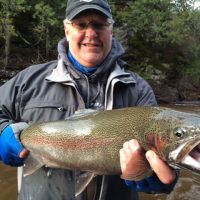Part of the problem with most outdoor entertainment type shows is there are guides and/or they are on an awesome body of water, setup with perfect timing. Granted it’s fun to watch great sticks catch fish after fish in a perfect boat, with perfect camera angles and in perfect weather. But there’s a reason uncut angler’s 39 hours was such a big hit, it took a different angle to the grip and grin shows. It showed dirty trucks, dirty boats and the climb to get up the mountain, making it more enjoyable to know the effort that went into the hero shot on the peak. There’s nothing that separates the vast majority of outdoor tv promotional shows. Now since youtube and the interweb came on the scene there’s a lot of different ideas and platforms to show off how every Tom, Richard or Harry is catching fish from an infinite number of angles, in an infinite amount of areas and times. Without the constant pitching or commercials for product sponsors. Although pitching is a necessary evil, people see through stuff way faster now than they did a decade ago. Lets face it there’s entertainment and then there’s learning tutorials. Very rarely can those two niches intertwine well. It’s interesting to see the hurdles, failures and frustration that leads to success vs just seeing the finished product.
One thing I’d like to see more of is not timing hitting a spot perfectly. Now it’s inbreed within us to see that as failure. But it’d be great to see how great sticks handle really adverse conditions. Like hitting pool 4 when everything is wrong vs when conditions are ideal for a clinic to be put on, on both numbers and size. Or on areas that are heavily fished, on a Sunday afternoon, that takes real skill and perseverance to pull off.
But that doesn’t always make for good tv viewing.
It’d be nice to see good anglers picking apart a body of water and having to get to plan L, M, N, and O and P after the first part of the alphabet has been run through unsuccessfully and seeing how guides on Erie, Devils Lake, Leech, Lake of the Woods, Winnie, The Mississippi and St. Croix River’s, etc face the challenge of a hard day vs a picture perfect day. And how they read maps and say move from the original plan and how they dissect and brake down a game plan for fishing new bodies of water or even old bodies of water. That is a very hard thing to verbalize or explain and takes a really good balanced person and or team to twist a recipe out of an already cooked meal by a great chef, who is a great chef, but isn’t a great communicator.
There’s a few rivers around that could really produce interesting shows;
The Ottertail river for smallies.
The upper St. Louis for catfish, smallies and walleyes.
The lower St. Louis for walleyes.
The Rum river for smallies.
The Upper Mississippi river for smallies.
The upper St. Croix for smallies.
Some odd ball lakes to consider;
Minnetonka
Waconia
White Bear Lake
East and West Rush
Osakis
Ottertail
Benton
Winnie
Cass
Pelican by Orr.
Vermillion.
Lakes around the BWCA and in the NE.
The Red River for catfish.
I’d really like to learn the in’s and out’s of river fish and the where’s, why’s and when’s.
Weed walleye’s have been asked about a lot recently on forums, that could make for some entertaining shows.
Urban environments are an untapped goldmine for shows because there are becoming a lot more urban anglers that don’t have access to big boats rigged to the 9’s or cabins in lake country and are challenged to fish in areas surrounded by more concrete and asphalt than pine trees and aspens, with little to go on other than forums and word of mouth. Their fish might not always be huge and there might not be unbelievable numbers, but they are forced to deal with less than ideal situations, conditions or bodies of water.
There’s some really odd lakes in the south western part of the state in big ag country.
Big Stone, Traverse and the lakes out on the border country in the western part of the state are interesting shallow bodies of water. It’d be interesting to learn how guides and pro’s target fish in those dishpan, shallow, seemingly featureless bodies of water.
Teaching and remaining relevant is something those anglers who have lived in the Brainerd lakes area have been able to achieve for decades and that’s no easy task. They’ve been able to keep it entertaining and informative at the same time, tough goal to achieve over a long period of time without becoming redundant or stagnant. In Depth Outdoors seems to be on that same path and is a very informative show that doesn’t shy away from telling the viewers not only the patterns, time of year, etc but also a general location, all the while keeping it fun and entertaining. Keep up the good work and good luck chasing down ways to make a great show even better!
